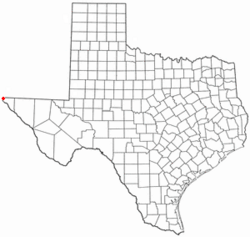Vinton, Texas facts for kids
Quick facts for kids
Vinton, Texas
|
|
|---|---|
|
Village
|
|

Location of Vinton, Texas
|
|
 |
|
| Country | United States |
| State | Texas |
| County | El Paso |
| Incorporated | 1961 |
| Government | |
| • Type | Mayor-council |
| Area | |
| • Total | 2.74 sq mi (7.10 km2) |
| • Land | 2.74 sq mi (7.10 km2) |
| • Water | 0.00 sq mi (0.00 km2) |
| Elevation | 3,839 ft (1,170 m) |
| Population
(2020)
|
|
| • Total | 2,684 |
| • Density | 979.6/sq mi (378.0/km2) |
| Time zone | UTC-7 (Mountain (MST)) |
| • Summer (DST) | UTC-6 (MDT) |
| ZIP code |
79821
|
| Area code(s) | 915 |
| FIPS code | 48-75668 |
| GNIS feature ID | 2413596 |
Vinton is a village in El Paso County, Texas, United States. The population was 2,684 at the 2020 census. It is part of the El Paso Metropolitan Statistical Area.
History
Native Americans inhabited the site of Vinton before the arrival of the Spaniards, who made it a stopping place along the Camino Real, the road from El Paso to Santa Fe, which passed along the east bank of the Rio Grande through what is now Vinton. In Spanish and Mexican colonial times, it was known as La Salinera, from the salt cedars which grew there in abundance; when the area passed to the United States after the US-Mexican War, this water stop became known as Cottonwood, and was located in the northern part of Vinton along the river, 22 miles from El Paso. In 1857, it was used by the San Antonio-San Diego Mail Line and from 1858 to 1861 by the Butterfield Overland Mail, that had a stage station called Cottonwood Station, located 22 miles from El Paso and 25 miles from Fort Fillmore up river in New Mexico.
Vinton was named for Southern Pacific Railroad surveyor John C. Vinton, who laid the cross-country route for the railroad through the area in 1881, and was most likely established around that time. A post office was opened there in 1892, and the town grew slowly in the next 100 years, reaching 605 in 1990, then tripling in population in the following decade to 1892 in the 2000 census. The incorporation of Vinton as Village of Industry on August 8, 1961 originated with Border Steel Corporation, which opened a mill in town that year; now owned by Arcelor Mittal, it is still in operation.
Geography
According to the United States Census Bureau, the village has a total area of 2.4 square miles (6.2 km2), all land.
Demographics
| Historical population | |||
|---|---|---|---|
| Census | Pop. | %± | |
| 1980 | 372 | — | |
| 1990 | 605 | 62.6% | |
| 2000 | 1,892 | 212.7% | |
| 2010 | 1,971 | 4.2% | |
| 2020 | 2,684 | 36.2% | |
| U.S. Decennial Census | |||
2020 Census data
| Race | Number | Percentage |
|---|---|---|
| White (NH) | 363 | 13.52% |
| Black or African American (NH) | 70 | 2.61% |
| Native American or Alaska Native (NH) | 63 | 2.35% |
| Asian (NH) | 20 | 0.75% |
| Pacific Islander (NH) | 2 | 0.07% |
| Some Other Race (NH) | 6 | 0.22% |
| Mixed/Multi-Racial (NH) | 9 | 0.34% |
| Hispanic or Latino | 2,151 | 80.14% |
| Total | 2,684 |
As of the 2020 United States census, there were 2,684 people, 432 households, and 379 families residing in the village.
Education
Almost all of Vinton is served by the Canutillo Independent School District, while a small section is in the Anthony Independent School District. Childress Elementary School is located in the village, and it is zoned to Childress for pre-kindergarten to fifth grades, and Canutillo Middle School for sixth to eighth grades. High-school students attend Canutillo High School and may also attend Northwest Early College High School should they qualify for admission.
See also
 In Spanish: Vinton (Texas) para niños
In Spanish: Vinton (Texas) para niños

